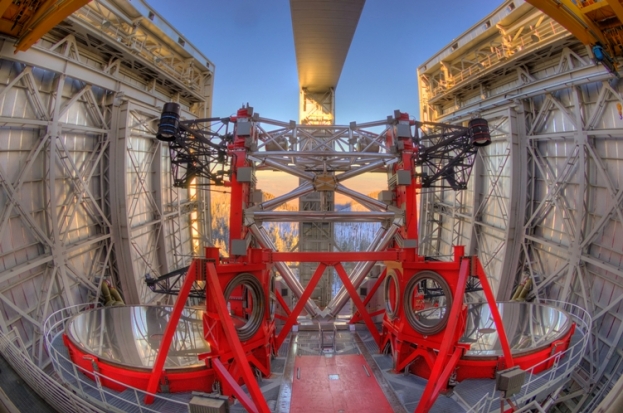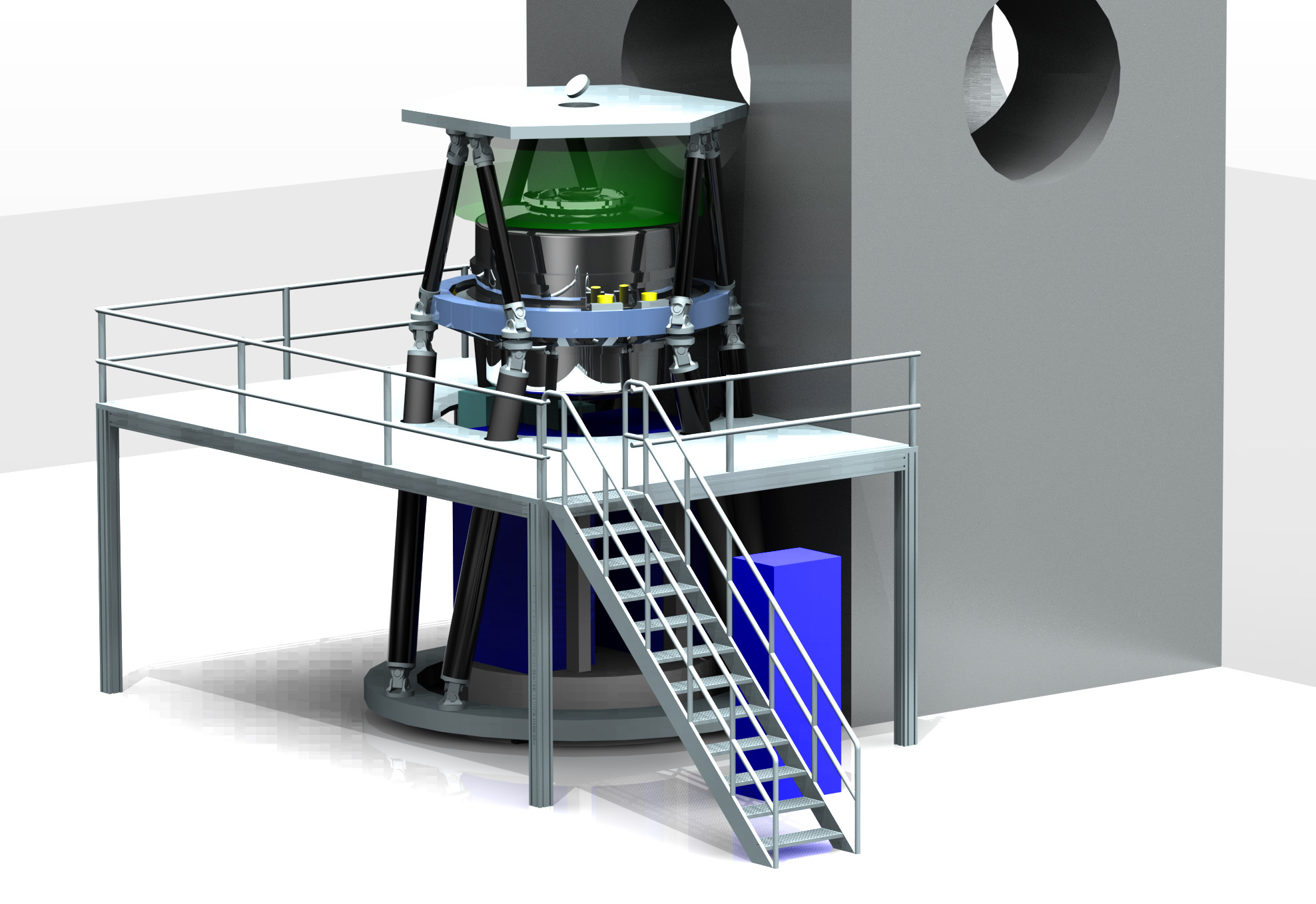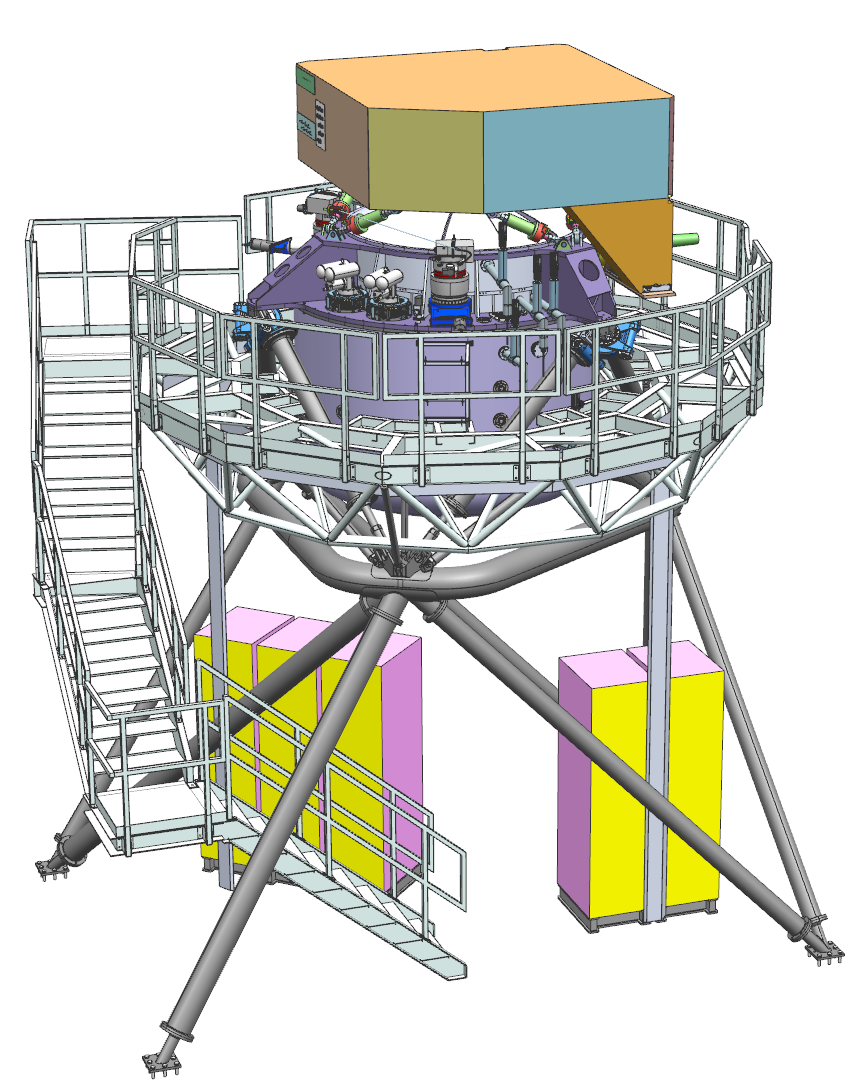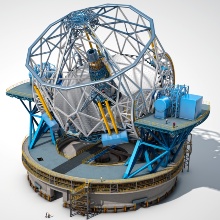Project Overview
The largest ground-based telescope, the Extremely Large Telescope (ELT), with a primary mirror diameter of 39 m is currently built in the Atacama desert in Chile. The diffraction limit will be five times and the light collection area 25 times larger than the current 8m-class large telescopes. First light of the telescope is expected in 2024, where the telescope is equipped with three instruments
- MICADO (Multi Adaptive Optics Imaging Camera for Deep Observations),
- METIS (Mid-infrared ELT Imager and Spectrograph),
- HARMONI (High Angular Resolution Monolithic Optical and Near-infrared Integral field spectrograph).
The Max Planck Institute for Astronomy (MPIA) is involved in the development and construction of MICADO and METIS within international consortia, where the Institute for Systemdynamics (ISYS) supports the MPIA in the field of advanced Adaptive Optics (AO) control.
Atmospheric turbulences and wind induced structural vibrations at the telescope disturb the images of the science cameras. To achieve diffraction-limited observations with the first light instruments, the ELT respectively the first light instruments are equipped with AO. The standard AO-control loop uses a wavefront sensor and a deformable mirror to measure and correct these disturbances.
Current Research Project
In this project, we investigate the impact of vibrations in the image magnification at the ELT on the performance of the MICADO instrument and the compensation of those. The current adaptive optics (AO) control loop is extended with an additional image magnification control (IMC) scheme using the image at the science detector (SD).
The MICADO instrument will be used with the optomechanical simpler SCAO mode in the first years of operation at the ELT. That comes with a serious limitation: Using one wavefront sensor (WFS), SCAO sharpens the image only towards one guide star (GS). That leaves the image magnification (R) as a free parameter, and telescope flexures and vibrations leading to a change of image magnification will smear out stars (S) towards the edge of the field. The ISYS works on a new control concept, where the image magnification vibrations are measured with the science detector (SD) directly and stabilized using the actuators of the relay optic (RO) and the telescope in an image magnification control (IMC) loop.
Goals of the project:
- Modeling of the image magnification based on structural vibrations
- Observer design for image magnification based on measurements at the science detector
- Development of an IMC loop using the actuators of the relay optic and the telescope
- Crosstalk analysis between the AO and the IMC loop
- Implementation and validation of the IMC loop at a test setup
This project is funded by the Federal Ministry of Education and Research.
Partner
Max Planck Institute for Astronomy (Heidelberg, Germany)
Responsible
Completed Research Projects
The Large Binocular Telescope (LBT) is the worlds most advanced optical and infrared telescope. It utilizes two symmetrical mirror system each of which has a primary mirror with 8.4m in diameter and an adaptive secondary mirror with approximately 1m in diameter. Research in this field is also done at this Institute, see above.
During operation of the telescope many unwanted vibrations occur, due to wind forces or even heavy machinery needed to operate the telescope inducing disturbances of high frequency. For incoming light, this results in a difference in the optical path to the detector between the two symmetric mirror systems leading to fringe pattern.
Therefore, this project aims at finding methods for reliably estimating the telescope's vibrations using available acceleration sensors. From this, the optical pathway difference has to be estimated. Subsequently, a controller will be designed for correcting the disturbed optical path by the means of an opto-mechanical cerrection device keeping the maximum phaseshift between the two optical paths below 100nm. The underlying control algorithm for the movable piezo-actuated optical correction device has also been developed at the ISYS.

The picture above was taken at the telescope's construction site and one can already see the large primary mirrors (attached to the red supporting structure) and the two adaptive secondary mirrors (at the extension arms painted black). The two adaptive secondary mirrors can deform their surface using 672 voice coil actuators each. This is used for real time phase shift correction of the incoming light to account for atmospheric turbulences.
The project was divided into five major parts:
- Mathematic modeling and simulation of the telescope
- Comparison of the simulation results to real measurement data
- Identification, validation and adjustment of the telescope model
- Observer design to estimate vibrations and the optical pathway difference
- Controller design for the opto-mechanical correction device
Partner
Max-Planck-Institut für Astronomie (Heidelberg, Germany), Large Binocular Telescope Observatory (Tucson, Arizona, USA)
Responsible
In this project we investigated the impact of structural vibrations at the ELT on the performance of the MICADO instrument and the compensation of those within the AO control loop. Current AO control concepts were extended with an additional accelerometer-based disturbance feedforward control to compensate the vibrations.

Due to the telescope mirror mounts high frequency vibrations (5 Hz – 50 Hz) are induced into the optical path and cannot fully mitigated for the observation with faint natural guide stars. The exposure time of the wavefront sensor is increased for a better signal-to-noise ratio, where the AO loop bandwidth is reduced. Therefore, the high frequency vibrations cannot be measured and are not available for compensation.
The ISYS works on a new control concept, where the structural vibrations are measured with additional accelerometers at the telescope mirrors. The vibrations can be measured with a faster sample rate and used for a disturbance feedforward control. This control concept has already been tested at the Large Binocular Telescope (LBT) for the compensation of the optical path difference due to vibrations in the LBT Interferometer (LBTI). In this project we extend the method for the compensation of the tip-tilt modes in the AO.
Goals of the project:
- Design and construction of a laboratory test setup to reconstruct the imaging distortions and the compensation
- Development of an accelerometer-based disturbance feedforward control for the tip-tilt modes
- Optimal distribution of the disturbances to M4 and M5 in connection with the disturbance feedforward control
- Transferring the results to MICADO and ELT
This project was funded by the Federal Ministry of Education and Research.
Partner
Max Planck Institute for Astronomy (Heidelberg, Germany)
Responsible
One goal of METIS is to find new exoplanets and to analyze their atmosphere in the mid-infrared regime (3 - 13 µm). In order to achieve the goals of METIS, images with maximum contrast are needed, which can only be achieved with a very fast (> 500 Hz) and extremely precise AO. In this project, we develop advanced AO controllers, which compensate atmospheric turbulences and structural vibrations for diffraction-limited observations.

The AO control loop of METIS consists of
- a pyramidal wavefront sensor to detect the image disturbances and
- the deformable mirror M4 and the tip-tilt mirror M5, to compensate these disturbances.
The deformable mirror M4, equipped with approx. 5400 actuators, can be deformed with a high spatial resolution and has a fast settling time. Because the M4-actuator strokes are limited, M4 cannot fully compensate the image disturbances dominated by tip-tilt. Therefore, the AO-control loop uses the tip-tilt mirror M5 additionally to M4. Since the mirror M5 has a diameter of approximately 2.5m, it can only provide limited compensation of high frequency disturbances.
Goals of the projects:
- Creating an AO end-to-end simulation
- modelling of atmospheric turbulences,
- modelling of structural vibrations,
- modelling the dynamic behavior of the active mirrors M4 and M5 at the ELT.
- Development of advanced model-based AO control concepts
- consideration of M4's stroke limitations,
- handling of faulty actuators in M4,
- concepts for splitting the distrubance compensation between M4 and M5.
Further information on METIS:
Partner
Max Planck Institute for Astronomy (Heidelberg, Germany)
Responsible
Publications
- , “Control oriented modelling and modal analysis of the deformable mirror M4 of the Extremely Large Telescope”, Mathematical and Computer Modelling of Dynamical Systems, 27, pp. 295-321, 2021, doi:10.1080/13873954.2020.1850480
- , “Improving the performance of interferometric imaging through the use of disturbance feedforward”, J. Opt. Soc. Am. A, 34, pp. A10-A21, 2017, doi:10.1364/JOSAA.34.000A10
- , “Investigations of an Accelerometer-based Disturbance Feedforward Control for Vibration Suppression in Adaptive Optics of Large Telescopes”, Publications of the Astronomical Society of the Pacific, 129, 2017, doi:10.1088/1538-3873/aa632b
- , “Delay Compensation for Real Time Disturbance Estimation at Extremely Large Telescopes”, IEEE Transactions on Control Systems Technology, 2016, doi:10.1109/TCST.2016.2601627
- , “Real Time Vibration Compensation for Large Telescopes”, Monthly Notices of the Royal Astronomical Society, 442, pp. 2446-2455, 2014, doi:10.1093/mnras/stu1012
- , “A Crossover Network based Control Concept for the Tip-Tilt Rejection in the Mid-Infrared ELT Imager and Spectrograph (METIS)”, IEEE/ASME International Conference on Advanced Intelligent Mechatronics (AIM), Boston (virtual), 2020
- , “An advanced SCAO control concept based on mechanical mirror modes for METIS”, SPIE Astronomical Telescopes + Instrumentation, San Diego, USA (virtual), 2020, doi:10.1117/12.2560623
- , “A new SCAO control concept based on mechanical mirror modes for METIS”, Adaptive Optics for Extremely Large Telescopes (AO4ELT6), Québec City, Canada, 2019
- , “Modellierung und Modalanalyse des deformierbaren Spiegels M4 im Extremely Large Telescope”, GMA FA 1.30, Salzburg, Austria, 2019
- , “OVMS-plus at the LBT. Disturbance compensation simplified.”, SPIE Conference on Astronomical Telescopes and Instrumentation, Edinburgh, UK, 2016, pp. 99062R, doi:10.1117/12.2231268
- , “Simultaneous Water Vapor and Dry Air Optical Path Length Measurements and Compensation with the Large Binocular Telescope Interferometer”, SPIE Conference on Astronomical Telescopes and Instrumentation, Edinburgh, UK, 2016, pp. 99071G, doi:10.1117/12.2233884
- , “Simulation of an Accelerometer-based Feedforward Vibration Suppression in an Adaptive Optics System for MICADO”, SPIE Conference on Astronomical Telescopes and Instrumentation, Edinburgh, UK, 2016, doi:10.1117/12.2231852
- , “Accelerometer-based online reconstruction of fast telescope vibrations from delayed measurements”, SPIE Conference on Astronomical Telescopes and Instrumentation, Edinburgh, UK, 2016, doi:10.1117/12.2231667
- , “Accelerometer-based online reconstruction of vibrations from delayed measurements”, IEEE Conference on Control Applications (CCA), Sydney, NSW, Australia, 2015, doi:10.1109/CCA.2015.7320666
- , “Real Time Estimation of Differential Piston at the LBT”, SPIE Conference on Astronomical Telescopes and Instrumentation, Montreal, Canada, 2014, doi:10.1117/12.2055833
- , “Accelerometer-based position reconstruction for the feedforward compensation of fast telescope vibrations in the E-ELT/MICADO”, SPIE Conference on Astronomical Telescopes and Instrumentation, Montreal, Canada, 2014, doi:10.1117/12.2053769
- , “Accelerometer-based online reconstruction of vibrations in extremely large telescopes”, IFAC World Congress, Cape Town, South Africa, 2014, pp. 7467-7473, doi:10.3182/20140824-6-ZA-1003.00265
- , “Modeling and Identification of the Optical Path at ELTs – a Case Study at the LBT”, IFAC Symposium on Mechatronic Systems, Hangzhou, China, 2013, pp. 249-255, doi:10.3182/20130410-3-CN-2034.00014
- , “An accelerometer based dual loop approach to minimize the impact of fast telescope vibrations seen by the E-ELT/MICADO wavefront sensors”, Adaptive Optics for Extremely Large Telescopes Conference (AO4ELT), Florence, Italy, 2013
- , “New developments at MPIA in Heidelberg to make AO more sensitive and precise”, Adaptive Optics for Extremely Large Telescopes Conference (AO4ELT), Florence, Italy, 2013
- , “Modelling the optical pathway of the Large Binocular Telescope”, SPIE Conference on Astronomical Telescopes and Instrumentation, Amsterdam, Netherlands, 2012, doi:10.1117/12.926293
- , “Development of new concepts to minimize the impact of fast telescope vibrations seen by the E-ELT/MICADO wavefront sensors”, SPIE Conference on Astronomical Telescopes and Instrumentation, Amsterdam, Netherlands, 2012, doi:10.1117/12.927030
- , “Intelligent vibration control of ELTs and large AO hardware”, SPIE Conference on Astronomical Telescopes and Instrumentation, Amsterdam, Netherlands, 2012, doi:10.1117/12.927028
- , “Strategies for Disturbance Compensation at Large Telescopes”, 2017
- , “Störgrößenkompensation im optischen Pfad von Riesenteleskopen mittels aktiver Optik”, 2013
Contact

Pascal Jaufmann
M.Sc.Research Assistant


